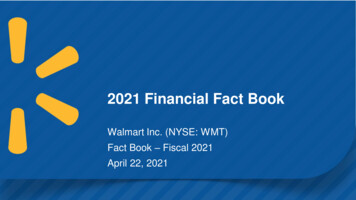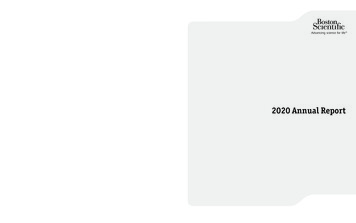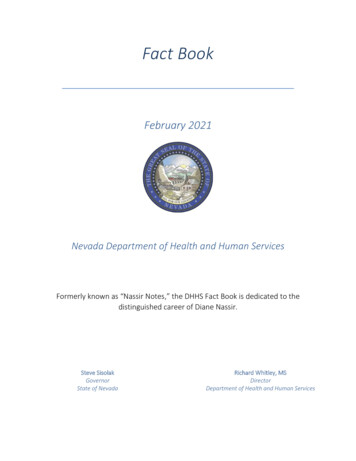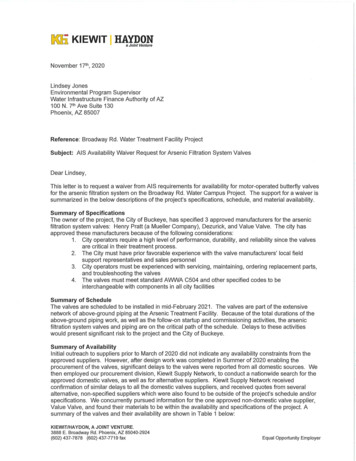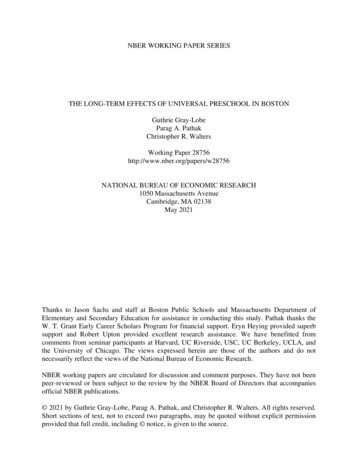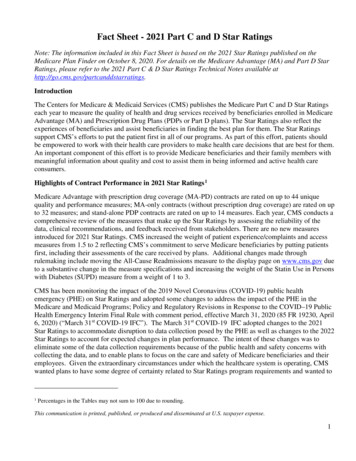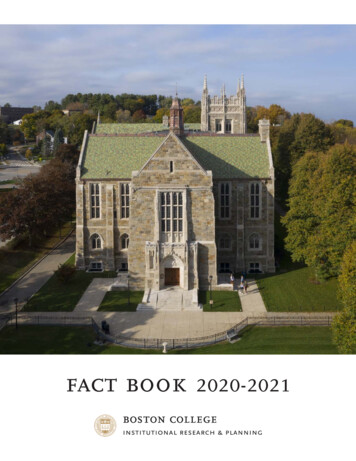
Transcription
fact book2020-2021
This page is intentionally blank
fact book2020-2021Current and past editions of the Boston College Fact Book are availableon the Boston College website: bc.edu/factbookInstitutional Research & Planning (IR&P): bc.edu/irp Trustees of Boston College 1983-2021
2foreword forewordInstitutional Research & Planning is pleased to present the Bostonthis publication an increasingly more useful reference, at the sameCollege Fact Book, 2020-2021, the 48th edition of this publication.time enhancing your understanding of the scope and progress of theUniversity. We welcome your comments and suggestions toward theseThis book is intended as a single, readily accessible, consistent sourcegoals.of information about the Boston College community, its resources,and its operations. It is a summary of institutional data gathered fromThis Fact Book, as well as those from previous years, is available in itsmany areas of the University, compiled to capture the 2019-2020 Fiscalentirety at bc.edu/factbook.and Academic Year, and the fall semester of the 2020-2021 AcademicYear. The Fact Book provides pertinent facts and figures valuableStephanie Chappe, Ph.D.to administrators, faculty, staff, and students. Where appropriate,Assistant Director, Institutional Researchmultiple years of data are provided for historical perspective.Allison ReillySincere appreciation is extended to all contributors who offered theirData Graphic Designertime and expertise to maintain the greatest possible accuracy andstandardization of the data. Special thanks go to Gulsah GurkanInstitutional Research & Planningfor her extensive contributions. A concerted effort is made to makeDecember 2020the mission of boston collegeStrengthened by more than a century and a half of dedication toBoston College pursues this distinctive mission by serving society inacademic excellence, Boston College commits itself to the highestthree ways:standards of teaching and research in undergraduate, graduate and by fostering the rigorous intellectual development and theprofessional programs and to the pursuit of a just society throughreligious, ethical, and personal formation of its undergraduate,its own accomplishments, the work of its faculty and staff, and thegraduate, and professional students in order to prepare them forachievements of its graduates. It seeks both to advance its placecitizenship, service and leadership in a global society;among the nation’s finest universities and to bring to the company by producing nationally and internationally significant researchof its distinguished peers and to contemporary society the richness ofthat advances insight and understanding, thereby both enrichingthe Catholic intellectual ideal of a mutually illuminating relationshipculture and addressing important societal needs; andbetween religious faith and free intellectual inquiry. by committing itself to advance the dialogue between religiousbelief and other formative elements of culture through theBoston College draws inspiration for its academic and societalintellectual inquiry, teaching and learning, and the community lifemission from its distinctive religious tradition. As a Catholic andthat form the University.Jesuit university, it is rooted in a world view that encounters God inall creation and through all human activity, especially in the search forBoston College fulfills this mission with a deep concern for alltruth in every discipline, in the desire to learn, and in the call to livemembers of its community, with a recognition of the importantjustly together. In this spirit, the University regards the contributioncontribution a diverse student body, faculty and staff can offer, with aof different religious traditions and value systems as essential to thefirm commitment to academic freedom, and with a determination tofullness of its intellectual life and to the continuous development of itsexercise careful stewardship of its resources in pursuit of its academicdistinctive intellectual heritage.goals.Approved by the Board of Trustees, May 31, 1996
table of contentsadministration & facultyBoard of Trustees Membership. 14Chairs - Board of Trustees. 15Trustee Associates Membership. 16Officers of the University. 18Academic Administration. 18Academic Institutes and Centers. 19The Jesuit Community at Boston College.20The Saint Peter Faber Jesuit Community at Boston College 20Chart of Administration. 21Provost and Dean of Faculties Units.22Executive Vice President Units. 24Professional, Administrative, and Support Staff by Gender 25Professional, Administrative, and Support Staff by VP Area 26Restricted Funded Staff by Gender and FTE. 26Faculty:by School and Rank. 26by School and Gender . 27by School and Tenure Status. 27by Highest Degree Earned and Gender. 27by Rank and Gender .28by Highest Degree Earned and Rank.28Faculty, Teaching Fellows, and Teaching Assistants:Full-Time Equivalent by School.28by School and Department .29Faculty Salary:by Rank.30by Rank, Average Compared to AAUP Category 1.30studentsFull-Time First-Year Applications, Acceptances, and Enrollment 32Full-Time First-Year Enrollment by Gender and Citizenship 32Full-Time First-Year Enrollment by School. 32First-Year Admission Profile. 32Class of 2024 Applications, Acceptances, and Enrollment - Geographic Distribution .33Competitor Schools of Admitted First-Year Students - Class of 2023 34Undergraduate Transfer Students (Full-Time):Applications, Acceptances, and Enrollment.34by Type of Previous Institution and Gender.34Geographic Distribution of Undergraduate Students. 35 contentsForeword. 2The Mission of Boston College. 2A Brief History of Boston College. 6A Boston College Chronology. 7Boston College Profile. 113
4table of contents (cont.) contentsstudents (cont.)Enrollment:by School, Gender, and Status . 36Student Credit Hours by School (Fiscal Year). 36by School, Gender, and Status (Five Years). 37by Race/Ethnicity, Gender, and Citizenship. 38Full-Time Equivalent Enrollment by School. 39Summer Session Enrollment. 39Undergraduates Studying Abroad.40Graduate Enrollment by Degree and Program. 41Undergraduate Majors by School. 42Undergraduate Minors by School. 43Most Popular Undergraduate Majors.44Disciplines with Largest Percent Increase in Undergraduate Majors 44Most Popular Undergraduate Minors.44International Students and Scholars:by School. 45by Class or Program. 45by Gender and Status. 45by Country.46Degrees Conferred:Undergraduate and Graduate by Degree and Gender. 47Undergraduate by Degree and Number of Majors.48Undergraduate by School and Major. 49Undergraduate by Major.50Graduate by School, Degree, Primary Field, and Gender 51Undergraduate Financial Aid:Dollars Awarded. 52Average Need-Based Financial Aid. 52Undergraduate Student Retention and Graduation Rates 53Competitive Fellowships and Awards. 53alumni & advancementAlumni Association Board of Directors. 56Alumni Association Regional Chapters. 56Alumni Awards. 56Living Alumni Geographic Distribution. 57Living Alumni by Primary School and Class.58Living Alumni by Gender and Class.60Gifts to the University. 61Individual Donors by Giving Club. 61Alumni Donors by Primary School and Class. 62physical plantBuildings Related to Boston College Operations.66Boston College Jesuit Community Owned Properties. 69Boston College Land and Buildings. 69
table of contents (cont.)5physical plant (cont.) contentsFacility Capacities. 70Summary of Building Use. 70Classrooms. 71Dining Facilities. 71Athletic and Recreation Outdoor Fields. 71Residence Hall Statistics by Building.72financeHighlights of Financial Operations. 76Condensed Statement of Financial Position.77Tuition and Fees. 78academic resources & research activityBoston College Libraries.80Boston College Library Holdings.80Expenditures for Library Materials.80Highlights of Sponsored Activities. 81Summary of Sponsored Funding Actions. 81Sponsored Projects:Source and Application of Funding. 82Expenditures by Sponsor Type. 82Number of Proposals Submitted and Principal Investigators 82athleticsVarsity Sports Records.84Intercollegiate Sports Participation.84Intramural Sports Participation. 85Club Sports Participation.86Margot Connell Recreation Center Visits and Group Fitness Classes 86general informationFounder of Boston College.88Presidents of Boston College.88Honorary Degrees and President’s Medals Awarded (Within Last Decade) 88Honorary Degrees Granted. 89Types of Degrees Conferred. 89Primary Accrediting Agencies. 89Association Memberships.90Academic Calendars. 91Fact Book Sources. 91Campus Maps. 92
6a brief history of boston college history & chronologyBoston College was founded by the Society of Jesus in 1863To honor its 150th anniversary in 2013, Boston College celebratedand, with three teachers and 22 students, opened its doors onthree semesters of activities, including a Mass at Fenway Park forSeptember 5, 1864. Through its first seven decades, it remained a20,000 alumni, students, faculty, and friends; academic symposia; asmall undergraduate institution, offering the sons of Boston’s Irishnaturalization ceremony; student and alumni service projects; and aworking class a rigorous course load in theology and philosophy,student concert at Symphony Hall.classical languages, rhetoric, math, and science.In 2016, Boston College was elevated to an R1 institution by theOriginally located on Harrison Avenue in Boston’s South End, theCarnegie Foundation, a designation for doctoral universities withCollege outgrew its urban setting early in the twentieth century andthe highest research activity classification, and concluded its Lightmoved to the former Lawrence Farm in Chestnut Hill, where groundthe World capital campaign, having raised a record-breaking total ofwas broken on June 19, 1909, for the construction of a central 1.605 billion in support of academic programs, student financial aid,Recitation Building, later named Gasson Hall in honor of Presidentfaculty research, student formation initiatives, and capital projects.Thomas I. Gasson, S.J., who led the relocation. The RecitationBuilding opened in March 1913. The three other buildings that stillIn 2017, the University announced a new 10-year strategic plan,shape the core of the campus—St. Mary’s Hall, Devlin Hall, andEver to Excel: Advancing Boston College’s Mission, which includes aBapst Library—opened in 1917, 1924, and 1928, respectively.commitment to liberal arts education, formation, research, and anincreased presence and impact locally and globally.Though incorporated as a university since its founding, BostonCollege did not begin to fill out the dimensions of its university charterConstruction of the 150,000-square-foot integrated science buildinguntil the 1920s, with the inauguration of a graduate school of artsthat will house the Schiller Institute for Integrated Science andand sciences, the Law School, and the Evening College, today calledSociety began in 2019, with a completion date of 2021. In 2020, thethe James A. Woods, S.J., College of Advancing Studies. The 1930sUniversity began recruiting its first class of students for its human-saw the introduction of the Graduate School of Social Work, now thecentered engineering major.Boston College School of Social Work, and the College of BusinessAdministration, today the Wallace E. Carroll School of Management.Pine Manor College in Brookline integrated with Boston College inThe School of Nursing—named in honor of William F. Connell in2020. The Pine Manor Institute for Student Success will serve first-2003—and the School of Education and Human Development—generation, low-income students from both schools through a 50named in 1999 for Carolyn A. and Peter S. Lynch—followed in 1947million endowment established by Boston College.and 1952, respectively. The oldest and largest of the University’seight schools and colleges, the Robert J. Morrissey College of Artsand Sciences, was named in 2015 in honor of alumnus RobertMorrissey, Boston College’s largest benefactor.In 1974, Boston College acquired a 40-acre site 1.5 miles from theChestnut Hill Campus that had been owned by Newton College ofthe Sacred Heart. The land is the present site of the Boston CollegeLaw School and of residence halls housing some 800 freshmen.Between 2004 and 2007, the University acquired a 65-acre parcelfrom the Archdiocese of Boston, just across Commonwealth Avenuein Brighton. The Brighton Campus is now home to the School ofTheology and Ministry, which was established in 2008, the CadiganAlumni Center, the McMullen Museum of Art, and the UniversityConference Center.Source: Office of University Communications
a boston college chronology1863 Gov. John A. Andrew signed the charter of Boston College,April 1. The first meeting of the Boston College Trustees tookplace on July 6.1864 Boston College opened on September 5, with John Bapst, S.J.,as president, Robert Fulton, S.J., as dean, and 22 students.1877 Nine students received A.B. degrees at the firstCommencement on June 28.1883 Publication began on The Stylus, the Boston College literarymagazine.1946 To accommodate post-war enrollment, army surplus barracksbecame dormitories on the present site of Campion Hall; alarger office/classroom building was erected on the presentlocation of McGuinn Hall, and a recreation building on the siteof Cushing Hall.1947 Construction began on the first permanent building since thecompletion of Bapst in 1928, to house the College of BusinessAdministration (occupied in September, 1948). The School ofNursing opened on Newbury Street in Boston.1949 Boston College acquired the small reservoir on the LowerCampus. The Men’s Hockey team won its first national title atColorado Springs.1951 Completion of Lyons Hall.1907 Thomas I. Gasson, S.J., named president; purchased theLawrence Farm in Chestnut Hill for a new campus.1913 The first graduation ceremony took place on the Chestnut HillCampus on June 18. Four classes enrolled in the newly openedGasson Hall in September.1918 Conscription and voluntary enlistment for World War I reducedBoston College enrollment to 125 in October, down from 671two years earlier.1919 Boston College won its first major football victory, 5-3, overfavored Yale at New Haven. First issue of The Heights, studentweekly, printed November 17.1923 The Baseball team beat Holy Cross 4-1 before 30,000 at BravesField, June 18.1924 Summer School began.1925 Boston College began to fill out the dimensions of its charteras a university with the founding of the Graduate School ofArts and Sciences.1928 Bapst Library opened, the fourth of the early Maginnis andWalsh buildings. Weston Observatory, the seismologicalstation, was founded.1929 The Law School opened at 11 Beacon Street, and the EveningCollege began as “Boston College Intown” at 126 NewburyStreet, Boston.1935 Greek was no longer required for the A.B. degree.1952 The School of Education opened in September in GassonHall. Doctoral programs began in economics, education, andhistory, initiating an era of increased emphasis on graduateeducation.1954 The Law School moved to St. Thomas More Hall on theChestnut Hill Campus.1955 Claver, Loyola, and Xavier halls opened, the first studentresidences. The School of Education moved into CampionHall.1957 The Graduate School of Management opened. Alumni Stadiumwas dedicated September 21.1958 Latin was no longer required for the A.B. degree. The Collegeof Arts and Sciences Honors Program and the Scholar of theCollege Program began. The original gymnasium, RobertsCenter, and the first hockey rink, McHugh Forum, opened.1960 The School of Nursing occupied its campus building, CushingHall. Three more student residences, named for the earlybishops of Boston, Cheverus, Fenwick, and Fitzpatrick, werecompleted.1961 McElroy Commons opened.1963 President John F. Kennedy addressed the Boston CollegeCentennial Convocation on April 20. The self-study of theCollege of Arts and Sciences led to a new core curriculum,a reduction in the course load, the election of departmentchairmen, the establishment of Educational Policy committees,and sabbaticals.1936 The Graduate School of Social Work opened at Newbury Street.1938 The School of Management opened at Newbury Street as the“College of Business Administration.”1964 Carney Hall opened. Students moved into Welch, Williams, andRoncalli residences.1966 Dedication of Higgins Hall in November.1940 The Football team traveled to its first bowl game — the CottonBowl — and was defeated by Clemson (6-3).1941 Cardinal William O’Connell obtained the Liggett estate, thefuture site of Upper Campus, and gifted it to the University.1968 The Board of Regents joined the Jesuit Trustees to form theBoard of Directors on October 8. The Black Talent Program,precursor to AHANA Student Programs, began. history & chronology1857 John McElroy, S.J., purchased property in the South End ofBoston for a new college.7
8a boston college chronology history & chronology1970 Women were admitted for degrees in all undergraduatecolleges. The modular residences were placed on the LowerCampus. PULSE, an academic/social action program, and theCampus School for children with multiple disabilities began.1971 The offices of President of Boston College and Rector of theBoston College Jesuit Community were separated on January 1.Installation of Omicron Chapter, Phi Beta Kappa took place onApril 6.1972 J. Donald Monan, S.J., succeeded W. Seavey Joyce, S.J., aspresident on September 5. The Trustees voted to eliminatethe Board of Directors and to expand the Board of Trusteesto include laypeople. The newly structured Board of Trustees,with 35 members (13 Jesuits), elected Cornelius Owens ‘36chairman. The Women’s Center was established.1973 The Long-Range Fiscal Planning Committee presented to theTrustees a plan for balanced budgets for the succeeding fiveyears.1974 Newton College of the Sacred Heart became part of BostonCollege (announced March 11).1975 The Law School moved to the Newton Campus. Edmond’sHall was occupied in September.1976 The New Heights Advancement Campaign to raise 21 millionbegan in April. It would raise more than 25 million over thenext five years.1979 One thousand friends of Speaker of the House Thomas P.O’Neill, Jr. ‘36, gathered in Washington to establish the O’NeillChair in American Politics, December 9. The Graduate Schoolof Social Work established a doctoral degree program. TheRecreation Complex was named for Athletic Director William J.Flynn.1980 The Jesuit Community endowed the Thomas I. Gasson, S.J.,Chair for distinguished Jesuit scholars.1982 Walsh Hall residence was named in honor of former presidentMichae
College Fact Book, 2020-2021, the 48th edition of this publication. This book is intended as a single, readily accessible, consistent source of information about the Boston College community, its resources, and its operations. It is a summary of institutional data gathered from many areas of

